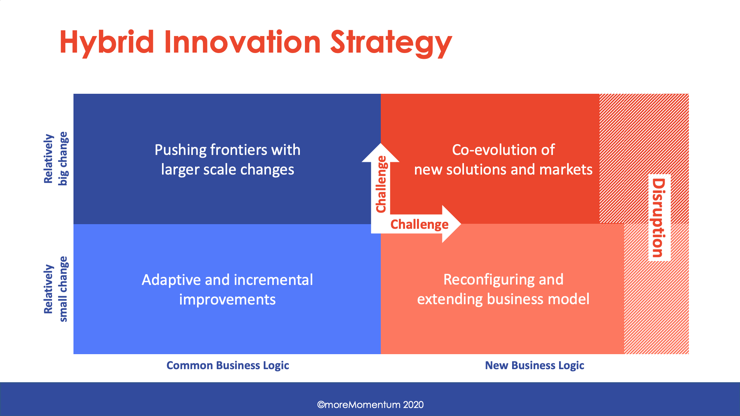Mastering the Innovation of Data-Driven Services
Mastering service innovation in data-driven solutions requires overcoming challenges like strategic alignment, balancing goals, and managing risks....
8 min read
Jan van Veen
Mar 18, 2025 1:03:16 PM

A balanced mix of sustaining, adjacent, and transformational innovations is essential for long-term success in B2B manufacturing, but many companies struggle due to unclear strategy, an overfocus on incremental improvements, and poor portfolio management.

Service innovation in B2B manufacturing is undergoing a fundamental shift. It is no longer just about improving efficiency or optimising service operations—it is becoming a primary driver of business growth. Digitalisation, sustainability, and changing customer expectations are reshaping the competitive landscape, demanding that manufacturers rethink their approach to service development.
For years, many companies have viewed service innovation as a support function—an add-on to their core product business. But today, leading manufacturers use service-oriented value propositions to differentiate, create new revenue streams, and future-proof their business. Digital and data-driven services are at the heart of this transformation, driving the performance of existing product-related services and driving growth by solving other (emerging) customer needs.
However, adapting to this new reality requires more than investing in the latest technologies. It demands a strategic approach to service innovation—one that balances sustaining, adjacent, and transformational innovations to drive short-, medium-, and long-term growth.
Many B2B manufacturers struggle to turn service innovation into a true growth engine. While they invest in service development, their innovation portfolios are not structured for long-term success. The result? Incremental improvements that maintain the status quo but fail to unlock new revenue streams, expand markets, or create disruptive value.
Innovation initiatives are often reactive rather than aligned with long-term business goals. Without a clear strategy, companies end up chasing trends (e.g., AI, predictive maintenance) rather than developing a service innovation roadmap for sustained growth.
Many companies over-invest in sustaining innovations that optimize current services but fail to drive market expansion or business model transformation.
Without structured portfolio governance, companies struggle to balance short-term efficiency gains, mid-term adjacencies, and long-term transformational opportunities.
Companies often prioritize today’s business needs over future opportunities, leading to underinvestment in disruptive innovation and missed growth potential.
To build a growth-driven innovation portfolio, companies need a structured approach that aligns innovation with strategy, applies proven portfolio management frameworks, and ensures disciplined resource allocation. The next section outlines how to achieve this.
Failing to balance an innovation portfolio is not just a missed opportunity—it is a direct threat to competitiveness. Companies that overinvest in sustaining innovations while neglecting adjacent and transformational innovation risk losing their market position to more agile, forward-thinking competitors.
The lesson from Amazon, Microsoft, Tesla, and other digital leaders is clear: Companies that structure their innovation portfolios for long-term growth consistently outperform those that do not.
Conversely, the failures of Kodak, Nokia, and traditional airlines serve as warnings: delaying innovation decisions reduces relevance to customers.
In fast-moving industries, companies that lead in service transformation capture new markets before others even recognise them.

In the early 2000s, most tech companies saw cloud computing as an internal infrastructure challenge. Amazon, however, recognized an untapped market for cloud-based services. By investing early in Amazon Web Services (AWS), they built an entirely new business model that now dominates the cloud computing industry. Traditional IT service providers, who were slow to respond, were left scrambling to catch up.
The pace of service innovation is accelerating, and incumbents are struggling to keep up. The most dangerous misconception is that companies will have time to react when the market shifts. In reality, disruption often happens faster than expected.

Nokia once dominated the mobile phone industry but failed to recognise the shift toward software-driven smartphones. While Apple and Google built ecosystems around apps and digital services, Nokia remained focused on hardware. By the time they tried to pivot, it was too late—competitors had already secured their market position.
In B2B manufacturing, service transformation follows the same pattern. Companies still sticking to traditional service will find it increasingly difficult to compete against data-driven, innovative service providers that offer greater value with lower friction.
Service innovation in B2B manufacturing must be strategic, balanced, and diversified to drive sustainable growth. Companies need a structured portfolio approach that ensures they are not just maintaining the status quo but also actively unlocking new market opportunities. A well-designed service innovation portfolio aligns with long-term business goals, diversifies investment across different types of innovation, and ensures measurable impact at every stage of development.
A service innovation portfolio must align with where the business wants to be in the future. This requires clarity on four key strategic questions:

Innovation should not be a disconnected effort; it should be an intentional part of the business strategy, directly contributing to service growth, profitability, and differentiation.
To structure an innovation portfolio effectively, companies must proactively identify emerging opportunities. This requires ongoing monitoring of:
Organisations should adopt a systematic approach to trend evaluation by monitoring weak and early signals. They can use tools such as scenario planning, ecosystem mapping, and early-stage prototyping to explore future service opportunities.
Each innovation initiative must be connected to the company’s service business objectives. This means searching for projects that enrich the portfolio in meaningful ways:
Several proven frameworks help organisations build a balanced, strategic service innovation portfolio.

The Hybrid Innovation Matrix categorizes innovation efforts based on two dimensions:
The matrix forms four quadrants:
A healthy innovation portfolio includes a mix of all three categories.

This model breaks down innovation opportunities into value promise (customer value), value delivery (service execution), and value capture (revenue model innovations). It encourages companies to explore multiple angles rather than focusing narrowly on one type of innovation, ensuring a balanced approach to service transformation and growth.
By exploring and integrating these tracks, manufacturers can uncover new opportunities for growth and differentiation in their service offerings.
A time-based model for balancing short-, mid-, and long-term innovation:

Companies should allocate resources strategically across these three horizons to maintain both short-term performance and long-term growth potential.
Different categories of service innovation should be explored:
Leadership engagement is critical. To gain executive support:
A successful innovation portfolio requires dedicated governance and funding mechanisms:
Innovation must extend beyond the R&D department. Companies should:
Service innovation is no longer an optional add-on for B2B manufacturers—it is a critical driver of growth, differentiation, and long-term success. However, too many companies remain trapped in incremental improvements, focusing on sustaining their existing business rather than unlocking new value.
To stay competitive in an era of digital transformation, changing customer expectations, and emerging service models, companies must structure their innovation portfolios strategically. This means balancing short-term efficiencies with mid-term expansions and long-term transformation.
A well-structured service innovation portfolio follows these essential principles:
The market is evolving at an increasing speed. Digital-first competitors, customer demands for new service-oriented value propositions, and sustainability-driven transformations are reshaping the landscape. Companies that fail to adapt risk falling behind, while those that take a proactive approach will lead the next era of service excellence.
Waiting to innovate is not an option. The gap between leaders and laggards is widening, and companies that fail to evolve will struggle to maintain relevance.
Now is the time for service leaders to take a hard look at their innovation portfolios and make strategic adjustments. Here’s what you can do today:
The companies that take action now will define the future of B2B services.
Innovation doesn’t happen in isolation. The most successful service leaders learn from each other, exchange ideas, and collaborate on new strategies. That’s why we’re bringing together global service executives, strategy leaders, and innovation pioneers at the Service Transformation Summit—the premier event for accelerating service transformation in B2B manufacturing.
At the summit, you will:
✅ Refine Your Innovation Portfolio – Gain hands-on insights into balancing sustaining, adjacent, and transformational innovations for long-term growth.
✅ Learn from Industry Leaders – Hear from companies that have successfully transformed their service businesses, driving new revenue streams and competitive advantage.
✅ Engage in Deep-Dive Discussions – Participate in interactive sessions and networking opportunities with peers facing similar challenges in service innovation.
✅ Discover Proven Frameworks & Strategies – Walk away with practical tools to assess and optimize your service innovation roadmap.
🔹 Step 1: Assess Your Innovation Portfolio – Use the frameworks shared in this article to evaluate your current approach.
🔹 Step 2: Register for the Service Transformation Summit – Join a global network of service innovators who are shaping the future of B2B services.
🔹 Step 3: Be Part of the Conversation – Share your challenges, ask questions, and connect with industry experts who can help guide your transformation journey.
👉 Check out this Service Transformation Summit today!
Check out the upcoming Service Transformation Summits:
Subscribe for the our Impulse Letter
With regular updates about service news, trends and best practices.

Mastering service innovation in data-driven solutions requires overcoming challenges like strategic alignment, balancing goals, and managing risks....

Driving your service innovation strategy is crucial for swift and effective transformation in B2B manufacturing. By aligning with corporate goals,...

Navigating innovation in B2B manufacturing is essential for transforming services into strategic business lines. Adopting tailored methodologies for...